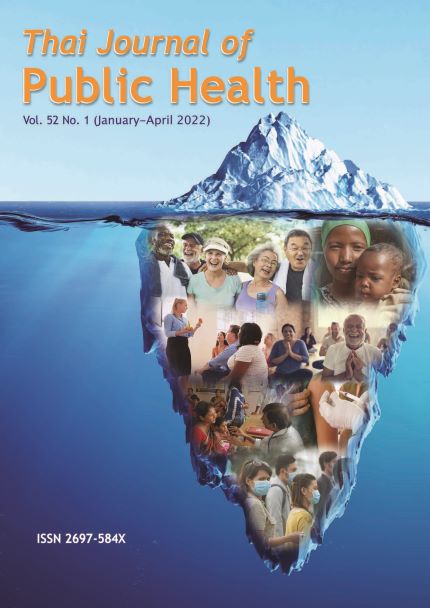Developing an Online Health Literacy Test on Tobacco for Youth
Keywords:
Health literacy, Tobacco, Online testAbstract
The smoking behavior survey conducted by the National Statistics Office in 2017 reported 7.9% (447,058) of people aged 15-19 were smokers. There have been several studies on information, education, and advocacy on tobacco control or smoking among young people. Some research suggests that health literacy is associated with health outcomes and behaviors, such as tobacco use. The aims of this research were to create online cigarette health literacy assessment tools and determine the quality of the research instrument by testing its validity and reliability.
The sample consisted of 364 secondary and high school students, who were randomly recruited from 12 school zones. The research tool was a situational assessment of youth smoking health literacy, which was developed as a web application that can be used in both Android and IOS smartphones by allowing respondents to choose an answer based on the dialogue of group chats. There were 43 questions on health literacy about cigarettes and e-cigarettes, consisting of cognitive (10 items), access to information (5 items), communication skills (8 items), decision-making skills (5 items), media literacy (5 items), and self-management (10 items).
The results of this research were as follows: 1. The 43 questions for health literacy on tobacco for youths were qualified for content validity by the IOC (Index of Item Objective Congruence) and the CVI (Content Validity Index) from five experts, which showed that questions were consistent with the definitions and behaviors. 2. Analysis of the power of discrimination was done by comparing the scores between the high and low scoring groups. Using the independent-samples t-test, it was found that 40 items were able to discriminate between the high and low group scores. 3. E-correlations between each item score and total score were 0.117 and 0.815 with p<0.05. 4. The Cronbach's alpha coefficient (a-Coefficient) was 0.840; the internal consistency of each item analysis by alpha if an item was deleted found that 37 items possessed homogeneity. 5. According to confirmatory factor analysis (CFA), the scale had a construct validity with a chi-square (c2) of 6.74 (df=5, p=0.2409, CFI=0.998, and RMSEA=0.031). The factor loading was between 0.435 and 0.767.
This online health literacy test for young people is an innovative tool because it uses technological methods combined with the concept of creating a question that turns the single question into a situational question. The dialogue of the characters in the scenario reflected the actual way in which people communicate today. Therefore, researchers who want to maintain respondents' interest can apply this concept in surveys or inquiries. However, the following matters must be considered: 1) the availability of the samples’ devices, 2) the length of the questions as this will affect the respondents' interest, therefore, the number of questions can be reduced to save time and prevent boredom, and 3) if this tool is to be used with a different group, the quality of the tool should be re-analyzed.
References
National Statistics Office. The smoking and drinking behavior survey 2017. Bangkok: Pimdeekarnpim Co., Ltd; 2018. (In Thai)
Yuan M, Cross SJ, Loughlin SE, Leslie FM. Nicotine and the adolescent brain. J Physiol 2015; 593(16): 3397-412.
Prutipinyo C, Sagoonhongsophol S, Taweepattana H. Hidden danger of e-cigarette. Bangkok: Chareondeemunkong Printing; 2019. (In Thai)
Sengphor K, Thornchew P, Uttama N, Pudphong S. Evaluation for developing “Three millions three years stop smoking throughout Thailand for the king: A case study in Phayao and Nan: Available from: http://www.trc.or.th/trcresearch/pdffiles/ART%2014/cat14%20(10).pdf, accessed 28 January 2021. (In Thai)
Stewart DW, Adams CE, Cano MA, Correa-Fernandez V, Li Y, Waters AJ, et al. Association between health literacy and established predictors of smoking cessation. Am J Public Health 2013; 103(7): e43–9 doi: 10.2105/AJPH.2012.301062.
Stewart DW, Cano MA, Correa-Fernandez V, Spears CA, Li Y, Waters AJ, et al. Lower health literacy predicts smoking relapse among racially/ethnically diverse smokers with low socioeconomic status. BMC Public Health 2014; 14:716 doi: 10.1186/1471-2458-14-716.
Parisod H, Axelin A, Smed J, Salantera S. Determinants of tobacco-related health literacy: A qualitative study with early adolescents. Int J Nurs Stud 2016; 62: 71-80. doi: 10.1016/j.ijnurstu.2016.07.012.
Trumikaborworn S. Health literacy for health promotion: Concept analysis. Journal of Nuring Khon Kaen University 2008; 31(2): 53-8. (In Thai)
Jindawong B. Validity and reliability of the Thai version of health literacy screening tools for patients at Srinagarind Hospital, Khon Kaen, Thailand [M.S. Thesis in Community Health Development] Khon Kaen: Khon Kaen University, Thailand; 2013. (In Thai)
Health Education Division. Health promotion and evaluation on health literacy and behavior. Available from: www.hed.go.th/220120180914085828_linkhed.pdf, accessed 28 January 2021. (In Thai)
Sujiva S. Cognitive skills of upper primary school students: A tentative model and an online test. Bangkok: National Institute of Educational Testing Service (Public Organization) 2016. (In Thai)
Sarakadeelite J. Chat novels break the record of 1 million readers a day, income (someone) hundreds of thousands a month. Available from: https://www.sarakadeelite.com/lite/read-joylada/, accessed 26 February 2021. (In Thai)
DeFranzo SE. Advantages and disadvantages of surveys. Available from: https://www.snapsurveys.com/blog/advantages-disadvantages-surveys/, accessed 8 January 2021.
National Statistics Office. Annual report 2018. Bangkok: Thana press; 2019. (In Thai)
Iglesias C, Torgerson D. Does length of questionnaire matter? A randomised trial of response rates to a mailed questionnaire. J Health Serv Res Policy 2000; 5(4): 219-21.
Chanreungrit C. Knowledge evaluation system (e-Testing): A case study of online test bank for license for professional practice. PULINET Journal 2016; 3(1): 112-7. (In Thai)
Pahea S. A development of the teacher profession to the education reform in the second decade. Seminar document; 2015. (In Thai)
Downloads
Published
Issue
Section
License

This work is licensed under a Creative Commons Attribution-NonCommercial-NoDerivatives 4.0 International License.
Creative Commons License CC-BY-ND


